Sérgio Valle Duarte
| Sergio Valle Duarte | |
|---|---|
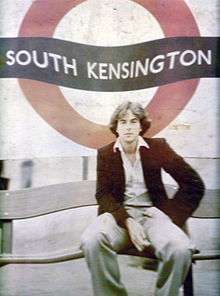 London 1976 | |
| Born |
September 26, 1954 São Paulo (São Paulo) Brazil |
| Nationality | Brazilian |
| Known for | Multimedia, photography, electrophotography |
| Movement | Contemporary art, BioArt |
Sergio Valle Duarte (born September 26, 1954), also known as Sergio Duarte, is a Brazilian multimedia artist and fine-art photographer.
Biography
Self-taught, he lives and works in Sao Paulo.[1] Between 1972 and 1974, he worked as an actor in television advertisements for Campari and Nestle.
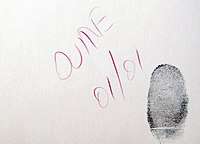
Due to the military dictatorship in Brazil, in 1976 he moved to London where he worked as assistant to Rex Features International Photographic Press Agency.
As freelance photographer, he followed pop music groups[2] The Who, Tangerine Dream, Genesis, Deep Purple, and ZZ Top. In 1977 Brazilian magazine Geração Pop (Editora Abril) featured a series of pictures he made in London of The Rolling Stones. Soon after, between Europe and South America, he collaborated with a range of magazines, Interview, Playboy, Vogue, Sony Style, (1978–1990). In those years he joined The Image Bank, Getty Images (1980–2005) and was featured in photography art magazines[2] Collector's Photography U.S.A., Zoom France, Special Bresil, Zoom Italy, Newlook France, Newlook USA, and Playboy (Brazil).
As Multimedia artist, since 1970, he participated in the exhibition New Media Art Multimedia 70/80 with the triptych "Video Oil" at the Armando Alvares Penteado Foundation, curated by Deysi Piccinini,[3] also the exhibition The plot of Taste another look at the daily, at the Julio Plaza installation Electronic Amusement with the project "Video Hypnosis" at the Biennial Foundation, São Paulo, 1985[4] and The First Quadrienal de Fotografias, curated by Paulo Klein at Museu de Arte Moderna de São Paulo, 1985.[5] Duarte evolved his work adding new technologies and techniques with digital images, electrophotography, Xerox art[6] conceptualizing artistically the reading of DNA and also in the future, the writing of DNA. To his portraits he sewed strands of hair of the models to allow them a future cloning.[6]
The model Gianne Albertoni is a part of the series that is featured in the permanent collection of museums in Europe and South America. The series is denominated by the artist as "Eletrografias e Fotografias com Fios de Cabelo para Futura Clonagem" (Electrophotographs and Photographs with Human Hair for Future Cloning), BioArt.[6][2]
Duarte is inspired by the surrealist tradition and the originality of his work resides in the fantastic colors and in the richness of details that he uses.[7] Irreverent, but never dramatic, with a playful irony, Duarte's works are constantly moving, dancing, flying, stretching, as if they are to expand out of the frame.[7]
During the 1980s, he befriended the Italian artist and philosopher Joseph Pace, founder in Paris of Filtranisme, a neo-existential philosophical and artistic current, joining, in 1990, the enlarged "filtranistes" group.[8]
Due to a leak in the roof of his artist studio at Spring Street during a summer storm in the late 1990s, much of his work was destroyed; it is rare to find analog works before this period.
He authenticates his works with a thumbprint.
Duarte focuses his personal expression interpreting freely sacred and profane themes. From 2005 to 2015 he collaborated as curator for Brazil for the Florence Biennale [9] and for the Padua Art Fair.
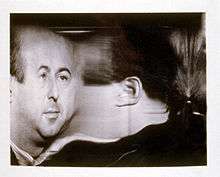
Collections
- Sao Paulo Museum of Modern Art, (Brazil)[10][6]
- Itaú Cultural, Sao Paulo, (Brazil)[6]
- Museum of Modern Art, Rio de Janeiro, Rio de Janeiro, (Brazil) [11]
- Yokohama Museum of Art, Yokohama, (Japan) [12]
- Musée de l'Élysée, Lausanne, (Switzerland) [13]
- Museum für Fotokopie, Mülheim, (Germany) [14]
- Auer Photo Foundation, Geneva, (Switzerland) [15]
- Museum Afro Brasil, Sao Paulo, (Brazil) [16]
- Musée Français de la Photographie, Bievres, (France) [17]
- Museum of Art of the Parliament of São Paulo (Brazil) [18]
Gallery
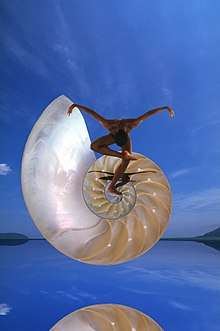 A Bowing in Art 1996
A Bowing in Art 1996


 A Wonderful Moment 1980. Oil on canvas.
A Wonderful Moment 1980. Oil on canvas.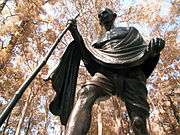
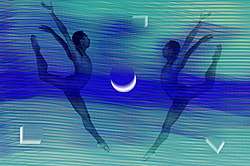
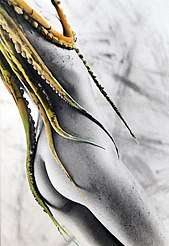 Re-reading of The Dream of the Fisherman's Wife 1988.
Re-reading of The Dream of the Fisherman's Wife 1988. Sergio Valle Duarte with friends 1994 - 1996
Sergio Valle Duarte with friends 1994 - 1996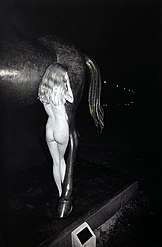 Equus 1989
Equus 1989
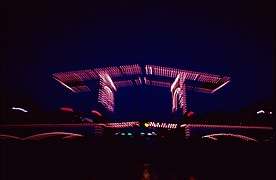
Selected bibliography
- Art Director's Index to Photographers Volume 7, 1981, pages 202-203 ISBN 2880460174 ISBN 9782880460174
- Art Director's Index to Photographers Volume 8, 1982, pages 312-313 ISBN 2880460220 ISBN 9782880460266
- Arteder , Muestra Internacional de Obra Grafica, Bilbao, Catalogo, 19 mar 1982 p. 154, 155, (Spain).
- Arlindo Machado, "Sergio Valle Duarte, as fantásticas paisagens dos sonhos", Folha de S.Paulo, 07 set. 1984, Ilustrada, p. 38 (Brazil).
- Art Director's Index to Photographers Volume 10, 1985, pages 292-293 ISBN 288046045X ISBN 9782880460457
- Arlindo Machado, " Os fantasmas e a realidade", Folha de Sao Paulo, Mar 6, 1985, Fotografia Critica, p. 45, (Brazil).
- Robert Louit " Portifolio Revista Zoom Internacional", 1985, edição 121, p. 26,27,28,29,30,31, França.
- Daysi Peccinini – "Arte Meios Multimeios 70/80" FAAP – Projeto Video Oil,1985,(Brazil). ISBN 978-85-98864-47-1 ISBN 8598864471
- Art Director's Index to Photographers Volume 11, 1986, pages 192- 193 ISBN 2880460514 ISBN 9782880460518
- Renato Janine Ribeiro "Um televerão", Folha de Sao Paulo, 04 de maio. 1986, Folhetim p. 2, (Brazil).
- José Américo Motta Pessanha" Imagem do corpo nu", Catalogo Funarte 1986, p. 25, 27, (Brazil).
- Ana Maria Guariglia, " Em fotos, união exótica de rostos e flores", Folha de Sao Paulo, 03 fev. 1988, Informatica p. 12, (Brazil).
- Art Director's Index to Photographers Volume 14, 1989, pages 136-137 ISBN 2880460824 ISBN 978-2880460822
- Pepe Escobar " Reflexos de Sao Paulo em Amsterdã" O Estado de Sao Paulo, Jun 20, 1989, Caderno 2, p. 66, (Brazil).
- NRC Handelsblad, " Musea", 21 junho 1989, p. 6,(Netherlands).
- Sadahiro Suzuki "World Photographic Exhibition" Catalogo, 1989. p. 54, (Japan).
- Klaus Urbons " Kunst und design mit dem Fotokopierer", DuMont Buchverlag,Kolm 1991, p. 164, 165, image 38, (Germany). ISBN 3-7701-2655-6 ISBN 978-3770126552
- Reynaldo Roels Jr. "Arte Erótica", Catalog Museum of Modern Art, Rio de Janeiro, 1993, p. 15 Brasil.
- Klaus Urbons " Elektrografie analog und digitale bilder", DuMont Buchverlag Kolm, 1994, p. 136 image 37, (Germany). ISBN 3-7701-3203-3 ISBN 9783770132034
- Paola Sammartano " Portifolio Revista Zoom Internacional" 1995, p. 62, 63, 64, 65, 66, 67, (Italy).
- Ivo Mesquita, Tadeu Chiarelli, Ricardo Mendes" Fotografias no acervo do Museu de Arte Moderna de Sao Paulo", 2002, p. 30, 31, (Brazil).
- Tadeu Chiarelli "Catalog geral do acervo do Museu de Arte Moderna de Sao Paulo", 2002, p. 85, 86, 87, 88, 89, (Brazil).
- Coleção Joaquim Paiva, "Visões e Alumbramentos" Museum of Modern Art, Rio de Janeiro", 2002, (Brazil). ISBN 8587742248 ISBN 978-8587742247
- Eduardo Bueno "São Paulo 450 anos em 24 horas", Bueno e Bueno 2004, p. 21, 22, 23, 197, (Brazil).
- Florençe Biennale, "Catalog",2007, p. 748, (Italy).[19]
- Emanuel Araújo " Esteticas, sueños utopias de los artistas de Brasil por la libertad", Imprensa Oficial 2010 p. 110, 124, (Brazil). ISBN 978-85-7060-816-1 ISBN 8570608160
- João j. Spinelli " Alex Vallauri Graffiti" Editora Bei, 2010 flap p. 176, 177, (Brazil). ISBN 978-85-7850-046-7 ISBN 8578500466
- Florence Biennale,"Catalog", 2011, p. 477,(Italy).[20]
References
- ↑ Duarte Sergio, Enciclopedia Itau Cultural
- 1 2 3 Photographers encyclopedia international
- ↑ "New Media Art Multimedia 70/80"
- ↑ "The plot of Taste" another look at the daily
- ↑ 1ª Quadrienal de Fotografia
- 1 2 3 4 5 Enciclopédia Itaú Cultural
- 1 2 Enciclopédia Itaú Cultural
- ↑ Letizia Fanari E&A Art: Joseph Pace Filtranisme, 2007, p. 24/25, Roma, Italia
- ↑ Florence Biennale
- ↑ Museu de Arte Moderna de Sao Paulo
- ↑ Photographers Encyclopedia International
- ↑ Photographers Encyclopedia International
- ↑ Photographers Encyclopedia International
- ↑ Photographers Encyclopedia International
- ↑ Photographers Encyclopedia International
- ↑ Photographers Encyclopedia International
- ↑ Photographers Encyclopedia International
- ↑ Photographers Encyclopedia International
- ↑ Florence Biennale 2007, Artists, Valle Duarte Sergio
- ↑ Florence Biennale 2011, Artists, Valle Duarte Sergio
External links
- The New York Public Library, P.I.C.
- Sao Paulo Museum of Modern Art
- "New Media Art Multimedia 70/80", Artists list, Enciclopédia Itaú Cultural de Arte e Cultura Brasileiras ISBN 978-85-7979-060-7
- " Electronic Amusement " 1985, Artists list , Enciclopédia Itaú Cultural de Arte e Cultura Brasileiras ISBN 978-85-7979-060-7
- "First Quadrienal de Fotografias" 1985, Artists list , Enciclopédia Itaú Cultural de Arte e Cultura Brasileiras ISBN 978-85-7979-060-7
- Museo de la Solidaridad Salvador Allende Santiago, Chile
- Enciclopedia Itau Cultural, Sao Paulo, (Brazil) - Museum citation
- Photographers Encyclopedia International from Auer Photo Foundation, Geneva, (Switzerland)- Museum citation
| Wikimedia Commons has media related to Sérgio Valle Duarte. |
.tif.jpg)